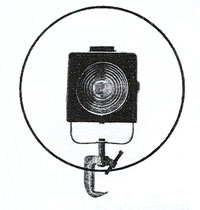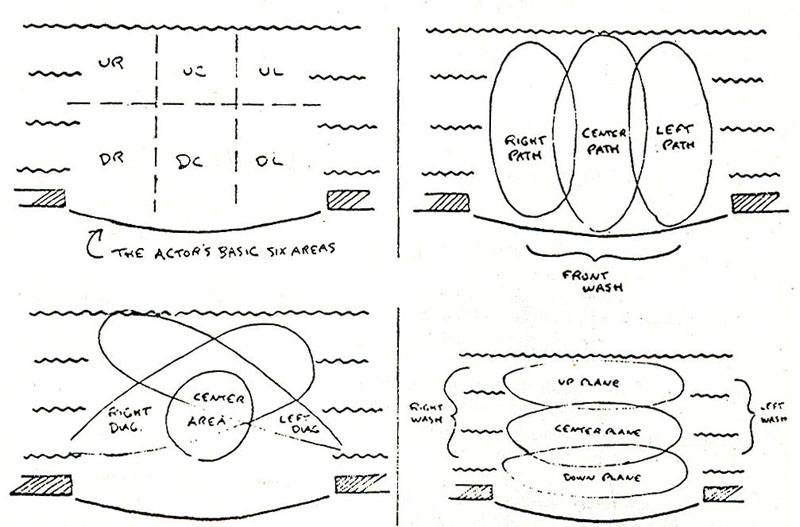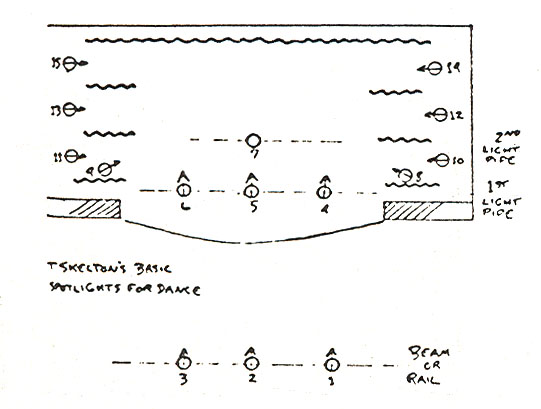

BY TOM SKELTON
courtesy of
Dance Magazine
first published
December 1955
PART III: LIGHTING (Cont’d)
The first concept of the “cross-spotting” system that we must re-evaluate is the use of basic area. The actor can choose any of the six areas in which to play a scene and, with the “cross-spotting” method, be assured that the chosen area can be properly emphasized. Dance uses the stage area in such a completely different way, however, that the six-area concept is completely useless when applied to dance. A movement might start in one area, but before the movement phrase is completed the dancer can easily have sliced through the edges of four other areas.
All of dance movement can be classified as using 12 basic areas, either one at a time or in combinations. I shall list the twelve areas, in the order of their importance, and include my short-hand name for each:
1) Upstage Center to Downstage Center (which I call center path).
2) The diagonal from Upstage Left to Downstage Right (right diagonal).
3) The diagonal from Upstage Right to Downstage Left (left diagonal).
4) A circle about 15 feet in diameter in the center of the stage (center area).
5) A strip about 5 feet in width running from one side of the stage to the other side of the stage, often corresponding to the entrances from the sides of the stage. These strips I call planes. Of first importance is the center plane.
6) Down plane which is just slightly upstage of the footlights.
7) Up plane which touches the upstage drapery or sky drop.
8) When the entire stage is lit from corner to corner by one set of instruments, each instrument located so that it hits the stage at the same angle, it is called a wash. Foot-lights, for example, produce a wash lighting. The most important dance wash is the right wash produced by instruments located on the right side of the stage.
9) Left wash from instruments in the wings on stage left.
10) Front wash from instruments located straight ahead in the “beams” and the “first light pipe”.
11) Upstage Right to Downstage Right (right path).
12) Upstage Left to Downstage Left (left path).

With as few as 15 spotlights, each of these areas can be covered separately. The center path will require a spotlight in the “beam”’ and a second spotlight on the “first pipe” (#2 and #5 on the diagram). Ditto the right path (#3 and #6) and the left path (#1 and #4). The three paths together equal the front wash. The center area spotlight can be mounted on the “first pipe”, or on the “second light pipe” and focused straight down (#7). The downstage plane will need two spotlights mounted on standards, one in the first entrance Downstage Right (#11), and the other in the first entrance Downstage Left (#10). Repeat with the center plane (#12 and #13) and the upstage plane (#14 and #15). Of these “wing lights”, the three on Stage Right equal the right wash, and the three on Stage Left equal the left wash. The right diagonal is covered by a spotlight located in the entrance Downstage Right (#9), usually mounted on a standard. The left diagonal then is Downstage Left (#8).

This setup is quite flexible in that most of the areas can receive secondary lighting from spotlights that are used primarily for another area. The center area, for instance, is covered by the right and left diagonals. The downstage plane is also covered by the three “beam” lights that are used in the front wash. Further flexibility is achieved by the fact that all 8 of the “wing lights” can be reached easily to change color and even focus during a performance, whereas in the “cross-spot” system all of the instruments are high overhead and cannot be changed easily.
A disadvantage of this system is that, since most of the spotlights serve double purposes each spotlight must be controlled separately. This would require 15 dimmers, which is not an exceptionally large number, but it is uncommon that a theatre that has only 15 spotlights will have as many as 15 dimmers. Therefore it will usually be necessary to group certain spotlights together on the same dimmer. This does not prove to be a major disadvantage, however, since a choreographer rarely uses all 12 areas; in fact most choreographers require emphasis on only three or four of these areas, and general or wash lighting can cover the rest of the stage.
I would like to illustrate this further by going into a little detail about the most commonly used areas. For lighting purposes there are three basic kinds of dance, each with different area requirements: ethnic dance, classical ballet, and modern ballet or modern dance.
Ethnic dance, perhaps since it originates in a circular area either enclosed by the spectators or in front of the object that motivates the dance, uses very limited dance areas. Ethnic dance of the “line” variety would probably uses the planes and paths more extensively, but “line” is a form of ethnic dance that I have never seen on the stage and therefore do not include in this discussion.
Ethnic dancing, it would seem, generally requires only the center path, center area, and occasionally center plane and downstage plane: three to seven spotlights. When the planes are not necessary I would suggest that the two diagonals be substituted to give variety of angle. Furthermore, these two spotlights can easily be changed in color and focus, which provides further variety.
Classical ballet requires right wash and left wash for the corps as it moves through the planes and paths. Front wash would cover the same area, but the side washes provide much more plasticity to the body since they are separated by 180 degrees. The soloists who step out of the corps usually work in the center area, occasionally crossing further downstage into the center path. The ballerina’s entrance, turns, and exit can be punched with the right diagonal. The pas de deux is in the center area, but the numerous entrances and exits make it advisable to keep the side washes high in reading.
Eight spotlights, then, are the minimum for classical ballet. If three extra spotlights are available, however, they would be most useful in the “beam” position (in other words, the downstage part of the front wash) at a dim reading, since the corps dancers frequently have the unfortunate habit of coming too close to the footlights where the side washes will not reach them. For this reason, furthermore, the footlights (which can give the underside of the tutu a pleasant blue tone) must be kept quite dim in reading so as not to distort the too-near dancer’s body by overemphasizing the legs, while the torso is in the shadows of the skirt.
Most of the choreographers of modern ballet have an intuitive or emotional feeling about certain of the dance areas. The feeling may be the result of an intellectual approach to space problems, or it may arise from custom or habit. It makes modern ballet very difficult to treat as a single concept, since each choreographer is so different. Jerome Robbins makes a sharp definition between the stage’s four planes, giving each a special quality. Jose Limon places special emphasis on the diagonals, but often bases a whole ballet on the relationship of one spot on the stage to the other areas. Martha Graham usually has a solo that starts in the center path, but apart from her unusual use of the down plane, her special areas are usually conditioned by the position of the settings. Anthony Tudor’s special concern seems to be with balancing the three stage paths, as though each had a psychological quality, against the center area of realism; but often he reverses this entirely and the center area becomes completely romantic. Doris Humphrey always requires emphasis in the center path, but the other areas differ with each ballet, the up plane and the diagonals being the most common.
Modern ballet is very interesting for the lighting designer, but should he have to cope with a combined program of modern and classical ballet, or a modern dance program of several choreographers, he’s facing a challenge that can be solved only with adequate equipment.
With this discussion of dance areas I have tried to demonstrate that a small amount of equipment can suffice. This presumes that all of the equipment is used to its maximum potential, and gelatine and focus changes must be made. A larger amount of equipment, naturally, will permit effects that are not feasible with a small amount of equipment, but does not necessarily assure better lighting, especially in the hands of an amateur technician, where the tendency is often towards quantity of effects rather than quality. On Broadway, because of the high cost of manpower, it is usually more feasible financially to have batteries of spotlights duplicated in different colors and different focus, rather than to attempt a change during the performance, for the major expense in lighting rental the initial outlay, and the small additional charge for a few extra spotlights can save a small fortune in labor costs.
The next “cross-spotting” concept that must be re-evaluated is the use of a mere 90 degrees to give the body form and dimension. The walls and ceilings of the actor’s scenery have forced the lighting designer to be contented with 90 degrees since he has very little choice of mounting positions for his spotlights. The dancer’s stage, however, is usually free and open to give him space in which to move, and fortunately this also gives his lighting designer unlimited mounting positions. The greatest dimension can be attained by only one light source from the side and only the specific visibility requirements of each ballet can determine how many other light sources may be necessary to fill in the shadows.
The other principle of “cross-spotting” that requires reconsideration is the concern with realism. The actor’s lighting designer is always in quest of a “motivating light source” such as the sun pouring in a window, or a bridge lamp or fireplace on stage) on which to base his color and angle. But the dancer seems to carry his “motivating light” within, and the audience so readily accepts the fact that dances is not “realistic” that it never expects realism. Realistic dance lighting then becomes an actual design device that can be quite useful and unusual, such as keeping an area of the stage that represents the interior of the dancer’s house or soul bathed in a warm color, and contrasting it with cold colors that represent reality or exteriors.
Next month’s article will take us further into lighting design, but for now check over these technical words to get them comfortably installed in your vocabulary:
Flies – area over the stage not in view of the audience. To “fly” scenery or light means to raise them into the “flies”.
In the Wings – area on the side of the stage no in view of the audience.
Wings or Legs – flats or draperies on the sides of the stage, parallel to the footlights, used to mask entrances. Spotlights mounted behind these “wings” or “legs” are called “wing lights”.
Tormentor – the first and farthest downstage “leg” or “wing”.
Borders or Teasers – flats or draperies running across the top and over the stage, parallel to the footlights, to mask the “flies” and whatever lighting equipment and scenery may be “hung” there. The “first light pipe” and “first borderlight” are usually behind the “first border” or “first teaser”.
X-ray – an old-fashioned word synonymous with borderlight.
Concert border – when all of the bulbs in the “first borderlight” are white, it is often called the “concert border”. Spotlights mounted on the “first light pipe” are often called “teaser spots” or “concert border spots”.
(to be continued)